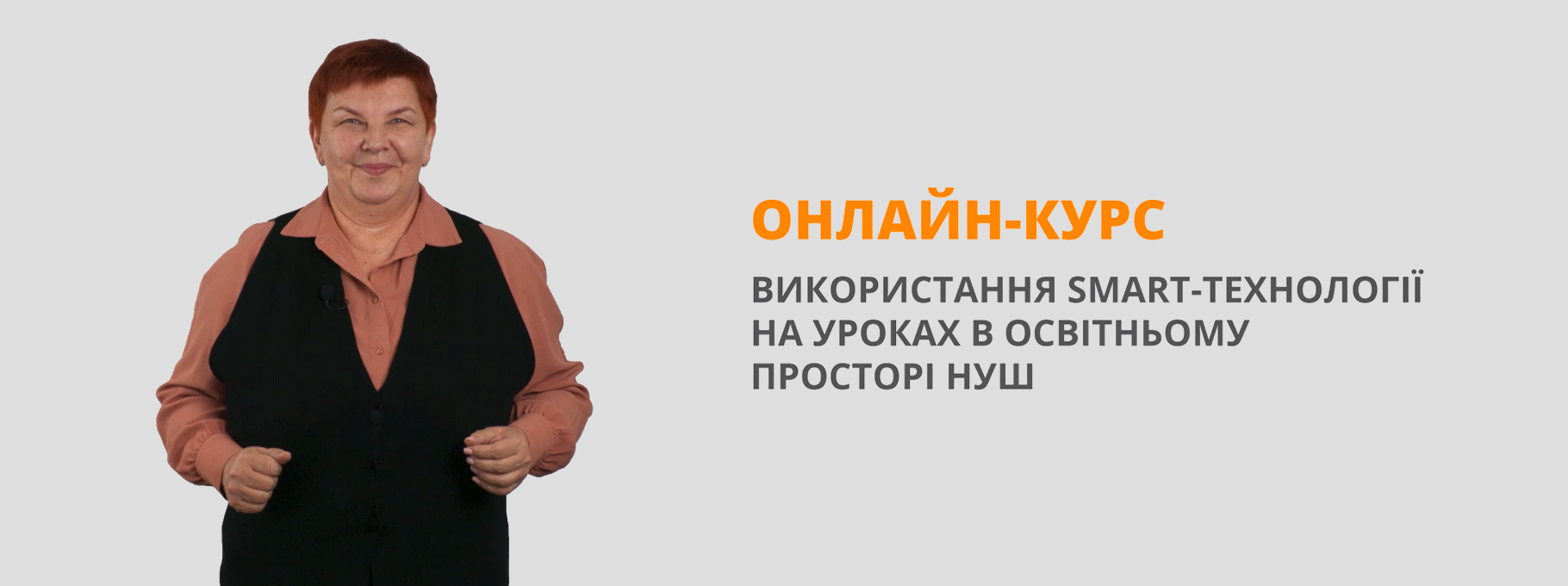Урок "Reading+Grammar (Past Simple)", Part 1
Розробка уроку англійської мови для роботи з учнями/студентами рівня Pre-Intermediate, за матеріалами підручника Face2Face Student's Book Pre-Intermediate by Chris Redston&Gillie Cunningham, 2012, Cambridge University Press
LESSONPLAN
COVER PAGE
|
Lesson Focus: Reading+Grammar |
Length: 60 min |
Level: Pre-intermediate |
|
Lesson Aim By the end of the lesson, students will be better able to use TL (affirmative and negative forms of the past simple in the context of stories or description of past events
Subsidiary Aim Practice reading for gist and for specific information
|
|
Materials
Handout 1, 2 and 6 taken from Face2Face Student’s Book Pre-Intermediate, Chris Redston&Gillie Gunnigham, 2012, Cambridge University Press, p. 14-15;
Handout 3 with created tasks;
Handout 4 adapted from Face2Face Student’s Book Pre-Intermediate, Chris Redston&Gillie Gunnigham, 2012, Cambridge University Press, p. 15;
Handout 5 and recordings taken from SpeakOut Pre-Intermediate Student’s Book by Antonia Clare and JJ Wilson, 2011, Pearson Longman, p.11 |
|
Assumptions The students will be familiar with the word order of Yes/No and WH- questions The students will know the verbs used in lesson |
|||
|
Anticipated problems (classroom management, content – NOT language):
1. Language presentation might take too long therefore students will not have much time for freer practice.
2. The recording for the phonology practice may not play
|
Solutions to these problems:
1. If students are doing well with the pronunciation features of regular forms there will be no need to do listening task, so we will have more time for freer practice. If we do not have much time for freer practice I will ask students to answer only 3 question to have time for feedback.
2. Be ready to read the words out – this will be ok as the recording lists the verbs in past simple.
|
||
|
White board plan: |
|||
|
Stage 2
a service station |
Stage 3
1 e |
Stage 3
1 T |
|
|
serve someone customer develop
|
2 b 3 g 4 c 5 h 6 f 7 d 8 a
|
|
2 F 3 T 4 F 5 T 6 F 7 F 8 F 9 T 10 F 11 T |
|
Stage 5
He stayed at home with his brother and sister Verb+ ed
His mother went to work in a factory Verb II
His father died when he was six Verb+ ed Be II They didn’t have a lot of money Didn’t + verb
|
Stage 5
. d . iz . . . t He stayed at home with his brother and sister and first learned to cook.
. . . His mother went to work in a factory
. .d . wez . His father died when he was six
didnt . . . Id . They didn’t have a lot of money so she needed to find a job.
|
||
|
Time |
Interact ion |
Stage & Aim |
Procedure |
|
1 min
3 min
2 min |
T-Ss
S-S
T-Ss |
1 Lead-in To engage the students into the context of the lesson |
Ask the students about their eating habits: “What do you usually have for breakfast? Which food do you like more homemade or fast food?”
Put students in pairs. Ask them to discuss questions: “What fast food companies are there in Kyiv? How often do you go there and what do you usually have to eat and to drink?”
Conduct an open class. Nominate students to answer. |
|
4 min |
T-Ss |
2 Pre-teach blocking vocabulary To unblock words necessary to understand the text |
Elicit meaning of the words asking questions: “What do we call a place at the side of the road where we can buy petrol, some food and other things?” - a service station, “What do waiters do when they bring you food and drinks in a restaurant?” - serve someone “What do we call a person that we serve in a restaurant?” - customer “What do we call it when we make a product better?” or “What do we call it when our skills become stronger?” - develop
Write them on the board. |
|
1 min
|
T-Ss
|
3 Reading To introduce the TL in the context. |
Tell students they are going to read an article about Harland Sanders, who started a fast food restaurant. |
|
3 min
2 min
2 min
1 min
4 min
3 min
2 min |
S
S-S
T-Ss
T-Ss
S
S-S
T-Ss |
To provide practice in reading for gist
To provide practice in reading for specific information
|
Chest Handout 1, tell them to read quickly and to put the events in the task in order. Set the time limit of 2 minutes. Give Handout 1 and 2.
Put students in pairs. Ask them to check in pairs. “Turn to your partner and talk about your answers. You have 2 minutes.” Conduct an open class. Write answers on the board.
Set the reading task: “You are going to read an article one more time. Then decide if the sentences in the task are True or False. You will have 4 minutes”. Give Handout 3
Put students in pairs. Ask them to check in pairs. “Turn to your partner and talk about your answers. You have 3 minutes.”
Conduct an open class. Write answers on the board. |
|
3 min |
T-Ss |
4 Highlighting To draw the students’ attention to the TL in the text
|
Ask students to find model sentences in the text: “What do we know about Harland’s family?” Elicit :“They didn’t have a lot of money” “His father died when he was six” “His mother went to work in a factory” “He stayed at home with his brother and sister” Write them on the board. |
|
2 min
|
T-Ss
|
5 Clarification To clarify meaning and form of affirmative and negative |
Elicit meaning of past simple: “Are these sentences about present or past?” - Past |
|
2 min
1 min
3 min
|
T-Ss
T-Ss
S
|
form of past simple
To draw the students’ attention to the TL in the text and to focus on form
|
“Are they in a progress?” – No, finished “Do we know when they happened?” - Yes
Elicit form of past simple: “He stayed at home with his brother and sister” Verb+ ed
“His mother went to work in a factory” Verb II
“His father died when he was six” Verb+ ed Be II “They didn’t have a lot of money” didn’t + verb
Chest Handout 4. Set the task: “Find the past simple of these verbs in the text Write them in the correct column to regular or irregular forms. You have 3 minutes.” Check understanding: “What verb forms do you need to find? Where will you write them?” Do first two verbs as an example. Give Handout 4. Ask students not to unfold the handouts.
|
|
3 min
2 min
3 min
2 min
|
SS T-Ss
T-Ss
S
SS T-Ss |
To clarify phonology of affirmative and negative form of regular and irregular past simple |
Ask students to pair-check. “In pairs talk about your results. You have 1 minute to compare your results.” Conduct an open class. Ask students to unfold the answers.
Elicit and highlight features of phonology in the sentences on the board in red. Draw students’ attention to three different ways to pronounce regular past simple. Ask: “What did his mother need to do? “What did he do when his mother went to work?” Elicit: “She needed to find a job. He stayed at home with his brother and sister and first learned to cook” Elicit and highlight features of phonology of regular past simple in red.
Chest Handout 5.Tell students they are going to listen to verbs in past simple: “Listen and write verbs in the correct column in the table” Give Handout 5.
Ask students to pair-check. “In pairs compare your results. You have 1 minute” Conduct an open class. Ask students to unfold handouts and see the answers. |
|
1 min
4 min
3 min |
T-Ss
S
SS |
6 Controlled practice To practice accurate use of the TL, to focus on form |
Tell the students they are going read about how another famous company started. “Read the article and put the verbs in past simple. Write the correct form in the gaps.” Draw students’ attention to the example in the text. Set the time limit: “You have 4 minutes to do it” Give Handout 6.
Put students in pair. Ask them to check in pairs: Turn to your partner. Talk about |
|
3 min |
T-Ss |
|
your answers. You have two minutes.
Conduct an open-class feedback. |
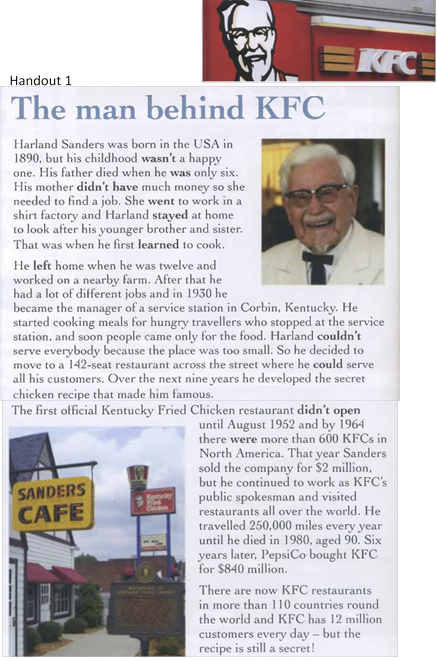
©.Taken from Face2Face Student’s Book Pre-Intermediate by Chris
Redston&Gillie Cunningham, 2012, Cambridge University Press, p.14
Handout 2 
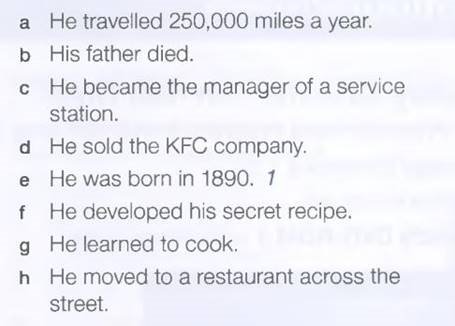
©.Taken from Face2Face Student’s Book Pre-Intermediate by Chris
Redston&Gillie Cunningham, 2012, Cambridge University Press, p.14
Handout 3
|
1. Harland’s father died in 1896. 2. His family had a lot of money. 3. He looked after his brother and sister. 4. His mother worked on a farm. 5. Harland had many jobs but he didn’t work on a factory.
6. He learned to cook at the service station. 7. Travelers didn’t like his food. 8. He developed a secret salad recipe that made him famous.
9. He opened his first KFC in 1952. 10. There were not many KFC restaurants in 1964. 11. He sold his company in 1964. |
T / F T / F T / F T / F T / F
T / F T / F T / F
T / F T / F T / F |
©.Created by Iryna Prysiazhniuk
Handout 4

|
Regular verbs |
|
Irregular verbs |
|
|
verb+ed |
verb+d
|
|
|
|
double consonant
|
no double consonant
|
||
Keys:
|
Regular verbs |
|
Irregular verbs |
|
|
verb+ed |
verb+d
died decided continued
|
had became came made sold bought |
|
|
double consonant
stopped travelled |
no double consonant
needed worked started developed visited |
||
©Adapted from Face2Face Pre-Intermediate Student’s Book by Chris Redston&Gillie Cunningham, 2012, Cambridge University Press, p.15
Handout 5
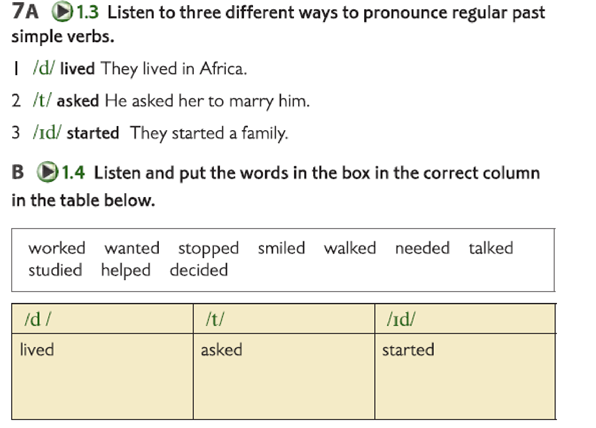
Keys:
|
/d/ |
/t/ |
/ɪd/ |
|
Lived Smiled
|
Asked Worked Stopped Walked Talked Helped |
Started Wanted Needed Studied decided |
©Taken from SpeakOut Pre-Intermediate Student’s Book by Antonia Clare and JJ Wilson, 2011, Pearson Longman, p.11
Handout 6
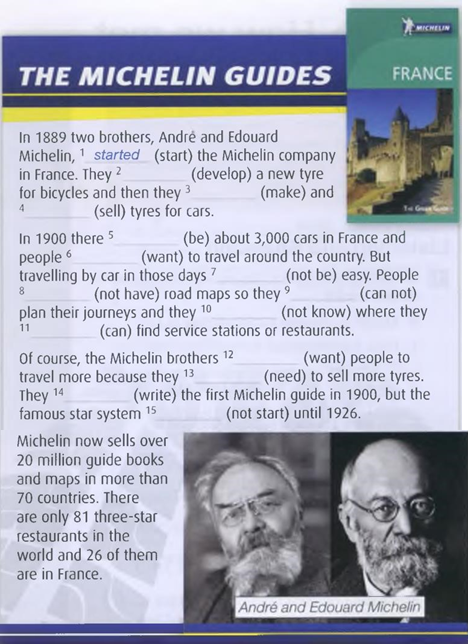
©Taken from Face2Face Pre-Intermediate Student’s Book by Chris Redston&Gillie
Cunningham, 2012, Cambridge University Press, p.15


про публікацію авторської розробки
Додати розробку
